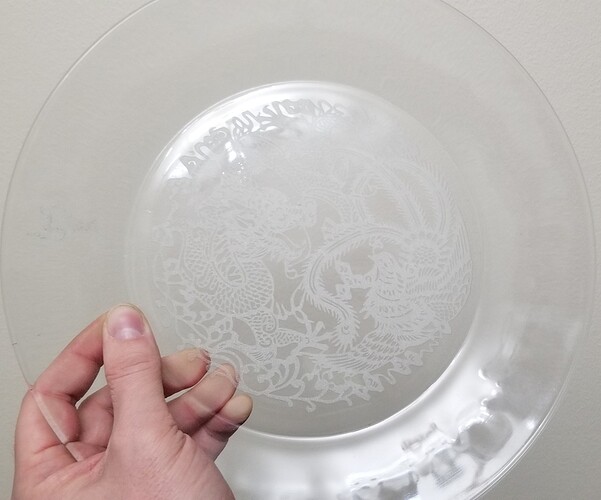Thanks James, that is what I thought.
John
ohh…Learning lots of new stuff!
I recall someone saying the cheaper the glass the better it lasered, implying higher quality glass shattered more. I have no idea if this is correct or not.
Somewhat correct. Mainly refering to crystal glass…
Lead crystal can easily shatter so its advised to use the cheaper lower quality.
Aka Dollar store glass as opposed to Macy’s…lol
What settings did you use? And if I am understanding this correctly you cover the surface of the shot glass with dish soap first then engrave?
There are a lot of variables why these settings might not be ideal for you but I have had pretty good luck with 950 / 100 at 340 LPI. I have been thinking about backing off the power a little on the next run. Yes, I put a light coating of dish soap over any part of the surface that will get engraved. To date, I think I have sold about four shot glasses. Will take a while to pay for my Glowforge at that rate but it’s a start.
I haven’t tried anything curved yet. Do you have a jig that holds the shoot glass? How much can you engrave at a time before the image/text looks warped? Do you cut the image/text into sections and rotate the glass between engraves?
Sorry for all the questions. I’m just curious as to how manual this process is.
I have a couple other posts where I describe my process and answer some of your questions…
So far, I have only made a single shot glass jig based on the 20 glass jig I designed.
I started seeing distortion on the edges when the design got a little more than 1" wide. I haven’t tried manually rotating to do a wider design but it should be possible.
Thank you! I will read through those.
So I had to test this myself with a glass plate.
Took about 45 minutes but came out very nice, really hard to photograph though (image is of a dragon and phoenix, more wedding stuff for my sister-in-law).
My wife now wants me to make customized holiday gifts for her co-workers.
What I can see of it is gorgeous! 
The reward for a good job is a harder job.
Very nice work.
From a photography standpoint, when shooting items like this a white background is the least preferred. Great design though.
Very true, I also found out I didn’t realize how few dark surfaces I have in my house that would make a good backdrop until I went looking 
I was about to use the dish soap method and then read on the back that it has Sodium Chloride. Wouldn’t that be a negative to laser, or not?
this is lovely… I’m trying out these settings - I’m engraving in the glass tops of jars for my first harvest of honey… since there is no mention of grey scale and converting to patterns/dithering…I’m assuming the file is a vector?
Yes, vector file.
In case no one has answered you privately, I don’t know why dishsoap works, but I know that the salt in it doesn’t prevent a good engrave. It acts like a super thin masking agent that’s water soluble. Masking agents are often latex or paper based, some are even thin plastic. That’s why they need to be applied evenly - thick globs or doubled layers will allow less lasering in that spot causing uneven engraving or cutting. In the case of glass, it tends to also prevent the heat from spreading on the surface, so there’s less fracturing. (Lasers on glass cause microfractures, which is how they get the engraves in the first place since glass doesn’t vaporize as easily as say acrylic or wood.)
Hope that helps!
Thank you your reply. My concern was with the chloride since various other chlorides are harmful to laser systems (e.g., vinyl, hydrogen, etc.). I can find liquid soaps without it, so I’ll go that route, but most dish soaps seem to have it. Do you have any info on this aspect?
Thanks again!
Ok, so let’s math it out:
Sodium chloride is table salt, 50/50 Na and Cl. On Dawn, it is the 5th ingredient, and since they are required by law to be listed in order of weight (unless less than 2%), assume that one gram of Dawn dishsoap has less than 10% of table salt in it (14 listed ingredients, it’s at least 20% water because liquid gel, breaking down by statistics and my working professional knowledge of manufacturing and labeling). >.1gram of table salt containing >.05g of chloride is negligible and unlikely to release a detectable gas when superheated, particularly when ventilation is applied.
Unlike PVC which is all that PVC is. And since it’s a 6th chloride, there’s .167g of chloride in a gram of PVC.
If you engraved a block of salt, you’d probably get some chlorine gas released and corrosive behaviour attacking the lense under the .5g to 1g rule as well.
Now the difference here is you’d only run into that 1 gram of Dawn soap applied in a thin layer to a 12x12 space. With a 12x12 vinyl film running at about 30grams (just a little over an ounce, per my thin stuff) on the top of the same 12x12 space, you’re getting 30 times the exposure. A 12x12 PVC sheet would engrave approximately 3 times the depth of a single PVC vinyl sheet (at approximately 4-6 oz weight) and there you’re looking at approximately 90grams of combusted exposure.
All in all, the soap is a negligible amount of Cl gas if released when all things are considered.
Anecdotes aside, I haven’t ever had an issue engraving through my Dawn soap.
